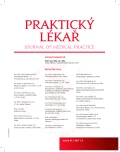Selected problems in female patients with relapsing-remitting sclerosis multiplex
Authors:
M. Miertová 1; A. Pľutová 2; A. Ovšonková 1; J. Čáp 1
Authors‘ workplace:
Univerzita Komenského v Bratislave
Jesseniova lekárska fakulta v Martine
Ústav ošetrovateľstva
Vedúca ústavu: prof. Mgr. Katarína Žiaková, PhD.
1; Nemocnica Snina, s. r. o.
Interné oddelenie
Vedúci oddelenia: MUDr. Daniel Bakši
2
Published in:
Prakt. Lék. 2017; 97(5): 228-234
Category:
Of different specialties
Overview
Aim:
The aim of the study was to describe, analyze and compare the variability of selected problems in the course of relapsing-remitting multiple sclerosis in female patients living at home and suggest the methods to solve them.
Methods:
A research strategy of a comparative multiple-case study design was chosen using both qualitative and quantitative methods. Three patients were included in the study.
Results:
All three patients experienced problems associated with the clinical signs of the disease and its progression, characterized by its interindividual variability. Walking difficulties, morning stiffness, urinary dysfunction, changes in sensitivity, fatigue, pain, sleep disorders, speech difficulties, disease-related concerns were reported as negatively perceived and troublesome.
Conclusion:
Since the onset of the disease, patients have been confronted with various problems which influence many areas of their life. With disease progression, various limitations in the functional state are present, and dependence on others is increasing. The identification of problems and their variability in subjective description by patients enables the healthcare staff to know and better understand the experience of the disease, which can contribute to individual approach to each patient, including the complex solution of his/her particular difficulties.
KEYWORDS:
relapsing-remitting multiple sclerosis – multiple-case study – interview – patients’ problems
Sources
1. Abolhassani S, Yazdannik A, Teleghani F, Zamani A. Expectations of multiple sclerosis patients and their families: a qualitative study in Iran. Iran Red Crescent Med J 2015; 17(2): 1–7.
2. Ambler Z. Neuropatická bolest – častá komponenta mnoha onemocnění. Neurol praxi 2011; 12(5): 329–333.
3. Basak T, Unver V, Demirkaya S. Activities of daily living and self-care agency in patients with multiple sclerosis for the first 10 years. Rehabil Nurs 2015; 40(1): 60–65.
4. Bóriková I. Posudzovanie aktivít denného života. Ošetřovatelství a porodní asistence 2010; 1(1): 24–30.
5. Bóriková I, Tomagová M, Žiaková K. Rizikové faktory pádu u hospitalizovaných pacientov. Prakt. Lék. 2017; 97(1): 23–30.
6. Diblík P, Kuthan P, Sklenka P. Neuritida zrakového nervu u roztroušené sklerózy mozkomíšní – typické obrazy a úskalí diferenciální diagnostiky. Neurol praxi 2011; 12(3): 156–159.
7. Ghafari S, Fallahi Khoshknab M, Nourozi K, Mohammadi E. Patients’ experiences of adapting to multiple sclerosis: qualitative study. Contemp Nurse 2015; 50(1): 36–49.
8. Ghafari S, Fallahi Khoshknab M, Norouzi K, Mohamadi E. Spousal support as experienced by people with multiple sclerosis: a qualitative study. J Neurosci Nurs 2014; 46(5): 15–24.
9. Gunn H, Creanor S, Haas B, et al. Risk factors for fall in multiple sclerosis: an observational study. Mult Scler 2013; 19(14): 1913–1922.
10. Grau-López L, Sierra S, Martínez-Cáceres E, Ramo-Tello C. Analysis of the pain in multiple sclerosis patients. Neurologia 2011; 26(4): 208–213.
11. Kantorová E, Kurča E, Michalik J. Hodnotenie kvality života pacientov so sclerosis multiplex. Neurol praxi 2012; 13(4): 213–215.
12. Kes VB, Čengić L, Cesarik M, et al. Quality of life in patients with multiple sclerosis. Acta Clin Croat 2013; 52(1): 107–111.
13. Koch T. Establishing rigour in qualitative research: the decision trail. J Adv Nurs 2006; 53(1): 91–100.
14. Lee J, Dunn J. Mobility concerns in multiple – sclerosis – studies and surveys on US patient populations of relevance to nurses. US Neurol 2013; 9(1): 18–23.
15. Leonavicius R, Adomaitiene V. Features of sleep disturbances in multiple sclerosis patients. Psychiatr Danub 2014; 26(3): 249–255.
16. Messina MJ, Costa GD, Rodegher M, et al. The communication of multiple sclerosis diagnosis: the patients’ perspective. [on line]. Mult Scler Int. 2015. Dostupné z: http://dx.doi.org/10.1155/2015/353828 [cit. 2017-06-06].
17. Miller PH. Dysarthria in multiple sclerosis. Clinical Bulletin. Information for Health Professionals. [on line] New York: National Multiple Sclerosis Society, 2011. 12 p. Dostupné z: https://www.nationalmssociety.org/NationalMSSociety/media/MSNationalFiles/Brochures/Clinical-Bulletin-Dysarthria.pdf [cit. 2017-05-22].
18. Morse JM, Morse RM, Tylko SJ. Development of a scale to identify the fall-prone patient. Can J Aging 1989; 8: 366–367.
19. Nemcová J, Hlinková E, a kol. Moderná edukácia v ošetrovateľstve. Martin: Osveta 2010.
20. Nemcová J, Hlinková E. The efficacy of diabetic foot care education. J Clin Nurs 2014; 23(5–6): 877–882.
21. Pavelek Z, Vališ M. Kognitivní deficit u roztroušené sklerózy mozkomíšní. Neurol praxi 2015; 16(6): 333–336.
22. Petrleničová D. Najčastejšie chyby v diagnostike roztrúsenej sklerózy. Via practica 2016; 13(1): 21–24.
23. Preziosi G, Dimitri A, Raptis DA, et al. Gut dysfunction in patients with multiple sclerosis and the role of spinal cord involvement in the disease. Eur J Gastroenterol Hepatol 2013; 25: 1044–1050.
24. Salehpoor G, Razaei S, Hosseininezhad M. Quality of life in multiple sclerosis (MS) and role of fatigue, depression, anxiety, and stress: A bicenter study from north of Iran. Iran J Nurs Midwifery Res 2014; 19(6): 593–599.
25. Sládková V. Diagnostika roztroušené sklerózy, typické klinické příznaky. Med praxi 2015; 12(5): 236–242.
26. Vališ M, Pavelek Z. Základní diagnostika a léčba roztroušené sklerózy. Via practica 2015; 12(4): 171–174.
27. Vališ M, Šimůnek L, Chrobok V, a kol. Poruchy polykání u neurologických onemocnění. Prakt. Lék. 2014; 94(6): 254–258.
28. Yin KR. Case Study Research: Design and Methods. Thousand Oaks: SAGE Publishing 2003.
Labels
General practitioner for children and adolescents General practitioner for adultsArticle was published in
General Practitioner

2017 Issue 5
Most read in this issue
- Functional disorders of the musculoskeletal system
- Selected problems in female patients with relapsing-remitting sclerosis multiplex
- Honey and health
- Health literacy of seniors and its impact on health and the use of health services
